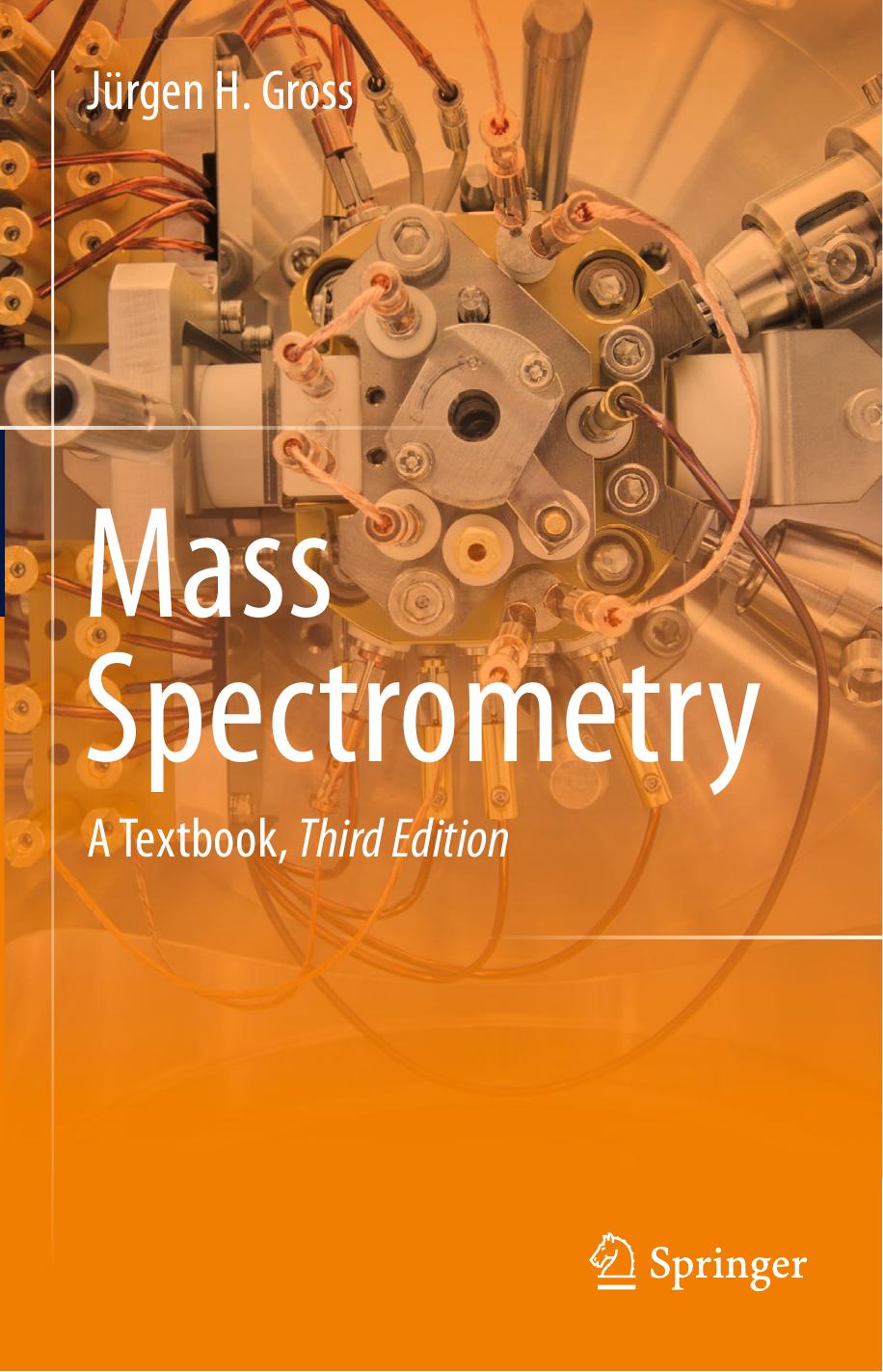
书籍简介
- Introduction
- Principles of Ionization and Ion Dissociation
- Isotopic Composition and Accurate Mass
- Instrumentation
- Practical Aspects of Electron Ionization
- Fragmentation of Organic Ions and Interpretation of EI Mass Spectra
- Chemical Ionization
- Field Ionization and Field Desorption
- Tandem Mass Spectrometry
- Fast Atom Bombardment
- Matrix-Assisted Laser Desorption/Ionization
- Electrospray Ionization
- Ambient Desorption/Ionization
- Hyphenated Methods
- Inorganic Mass Spectrometry
本书pdf是文字版,书签良好。
Introduction
1.1 Mass Spectrometry: Versatile and Indispensable
1.2 Historical Sketch
1.3 Aims and Scope of This Textbook
1.4 What Is Mass Spectrometry?
1.5 Ion Chromatograms
1.6 Performance of Mass Spectrometers
1.7 Terminology – General Aspects
1.8 Units, Physical Quantities, and Physical Constants
1.9 Further Reading
1.10 Quintessence
Principles of Ionization and Ion Dissociation
2.1 Gas Phase Ionization by Energetic Electrons
2.2 Vertical Transitions
2.3 Ionization Efficiency and Ionization Cross Section
2.4 Internal Energy and the Further Fate of Ions
2.5 Quasi-Equilibrium Theory
2.6 Time Scale of Events
2.7 Internal Energy – Practical Implications
2.8 Reverse Reactions – Activation Energy and Kinetic Energy Release
2.9 Isotope Effects
2.10 Determination of Ionization Energies
2.11 Determining the Appearance Energies
2.12 Gas Phase Basicity and Proton Affinity
2.13 Ion–Molecule Reactions
2.14 Summary of Gas Phase Ion Chemistry
Isotopic Composition and Accurate Mass
3.1 Isotopic Classification of the Elements
3.2 Calculation of Isotopic Distributions
3.3 Isotopic Enrichment and Isotopic Labeling
3.4 Resolution and Resolving Power
3.5 Accurate Mass
3.6 Applied High-Resolution Mass Spectrometry
3.7 Resolution Interacting with Isotopic Patterns
3.8 Charge State and Interaction with Isotopic Patterns
3.9 Approaches to Visualize Complex HR-MS Data Sets
3.10 Vantage Point on the World of Isotopes and Masses
Instrumentation
4.1 How to Create a Beam of Ions
4.2 Time-of-Flight Instruments
4.3 Magnetic Sector Instruments
4.4 Linear Quadrupole Instruments
4.5 Linear Quadrupole Ion Traps
4.6 Ion Trap with Three-Dimensional Quadrupole Field
4.7 Fourier Transform Ion Cyclotron Resonance
4.8 Orbitrap Analyzer
4.9 Hybrid Instruments
4.10 Ion Mobility-Mass Spectrometry Systems
4.11 Ion Detection
4.12 Vacuum Technology
4.13 Purchasing an Instrument
Practical Aspects of Electron Ionization
5.1 Electron Ionization Ion Sources
5.2 Sample Introduction
5.3 Pyrolysis Mass Spectrometry
5.4 Gas Chromatograph
5.5 Liquid Chromatograph
5.6 Low-Energy Electron Ionization Mass Spectra
5.7 Analytes for EI
5.8 Mass Analyzers for EI
5.9 Mass Spectral Databases for EI
5.10 EI in a Nutshell
Fragmentation of Organic Ions and Interpretation of EI Mass Spectra
6.1 Cleavage of a Sigma-Bond
6.2 Alpha-Cleavage
6.3 Distonic Ions
6.4 Benzylic Bond Cleavage
6.5 Allylic Bond Cleavage
6.6 Cleavage of Non-activated Bonds
6.7 Recognition of the Molecular Ion Peak
6.8 McLafferty Rearrangement
6.9 Retro-Diels-Alder Reaction
6.10 Elimination of Carbon Monoxide
6.11 Thermal Degradation Versus Ion Fragmentation
6.12 Alkene Loss from Onium Ions
6.13 Ion–Neutral Complexes
6.14 Ortho Elimination (Ortho Effect)
6.15 Heterocyclic Compounds
6.16 Guide to the Interpretation of Mass Spectra
Chemical Ionization
7.1 Basics of Chemical Ionization
7.2 Protonation in Chemical Ionization
7.3 Proton Transfer Reaction-Mass Spectrometry
7.4 Charge Transfer Chemical Ionization
7.5 Negative-Ion Chemical Ionization
7.6 Electron Capture Negative Ionization
7.7 Desorption Chemical Ionization
7.8 Atmospheric Pressure Chemical Ionization
7.9 Atmospheric Pressure Photoionization
7.10 Overview of CI, APCI, and APPI
Field Ionization and Field Desorption
8.1 Evolution of Field Ionization and Field Desorption
8.2 Field Ionization Process
8.3 FI and FD Ion Sources
8.4 Field Emitters
8.5 Field Ionization Mass Spectrometry
8.6 FD Spectra
8.7 Liquid Injection Field Desorption Ionization
8.8 General Properties of FI-MS and FD-MS
8.9 FI, FD, and LIFDI at a Glance
Tandem Mass Spectrometry
9.1 Concepts of Tandem Mass Spectrometry
9.2 Metastable Ion Dissociation
9.3 Collision-Induced Dissociation
9.4 Surface-Induced Dissociation
9.5 Tandem MS on TOF Instruments
9.6 Tandem MS with Magnetic Sector Instruments
9.7 Tandem MS with Linear Quadrupole Analyzers
9.8 Tandem MS with the Quadrupole Ion Trap
9.9 Tandem MS with Linear Quadrupole Ion Traps
9.10 Tandem MS with Orbitrap Instruments
9.11 Tandem MS with FT-ICR Instruments – Part I
9.12 Infrared Multiphoton Dissociation
9.13 Electron Capture Dissociation
9.14 Tandem MS with FT-ICR Instruments – Part II
9.15 Electron Transfer Dissociation
9.16 Electron Detachment Dissociation
9.17 Special Applications of Tandem MS
9.18 Tandem Mass Spectrometry Condensed
Fast Atom Bombardment
10.1 Brief Historical Sketch
10.2 Molecular Beam Solid Analysis
10.3 Ion Sources for FAB and LSIMS
10.4 Ion Formation in FAB and LSIMS
10.5 Liquid Matrices for FAB and LSIMS
10.6 Applications of FAB-MS
10.7 FAB and LSIMS: General Characteristics
10.8 Massive Cluster Impact
10.9 252Californium Plasma Desorption
10.10 Ionization by Particle Impact at a Glance
Matrix-Assisted Laser Desorption/Ionization
11.1 Ion Sources for LDI and MALDI
11.2 Ion Formation
11.3 MALDI Matrices
11.4 Sample Preparation
11.5 Applications of LDI
11.6 Applications of MALDI
11.7 Special Surfaces to Mimic the Matrix Effect
11.8 MALDI Mass Spectral Imaging
11.9 Atmospheric Pressure MALDI
11.10 Essentials of MALDI
Electrospray Ionization
12.1 Route Leading to Electrospray Ionization
12.2 Interfaces for Electrospray Ionization
12.3 Nanoelectrospray
12.4 Ion Formation in ESI
12.5 Multiply Charged Ions and Charge Deconvolution
12.6 Applications of ESI-MS
12.7 Electrospray Roundup
Ambient Desorption/Ionization
13.1 Concept of Ambient Desorption/Ionization
13.2 Desorption Electrospray Ionization
13.3 Desorption Atmospheric Pressure Chemical Ionization
13.4 Desorption Atmospheric Pressure Photoionization
13.5 Other Methods Related to DESI
13.6 Rapid Evaporative Ionization Mass Spectrometry
13.7 Atmospheric Pressure Solids Analysis Probe
13.8 Direct Analysis in Real Time
13.9 The World of Ambient Mass Spectrometry
Hyphenated Methods
14.1 Chromatography
14.2 Concept of Chromatography-Mass Spectrometry
14.3 Quantitation
14.4 Gas Chromatography-Mass Spectrometry
14.5 Liquid Chromatography-Mass Spectrometry
14.6 Ion Mobility Spectrometry-Mass Spectrometry
14.7 Tandem MS as a Complement to LC-MS
14.8 Ultrahigh-Resolution Mass Spectrometry
14.9 Summary of Hyphenated Techniques
Inorganic Mass Spectrometry
15.1 Concept and Techniques of Inorganic MS
15.2 Thermal Ionization Mass Spectrometry
15.3 Spark Source Mass Spectrometry
15.4 Glow Discharge Mass Spectrometry
15.5 Inductively Coupled Plasma Mass Spectrometry
15.6 Secondary Ion Mass Spectrometry
15.7 Accelerator Mass Spectrometry
15.8 Summary
Comments !